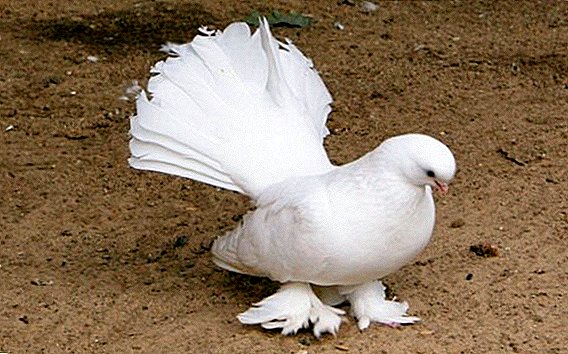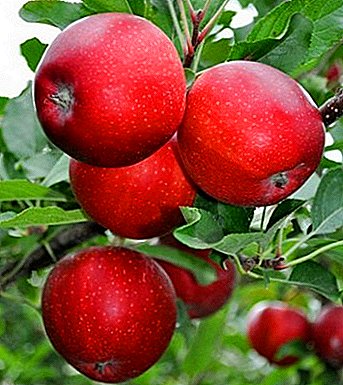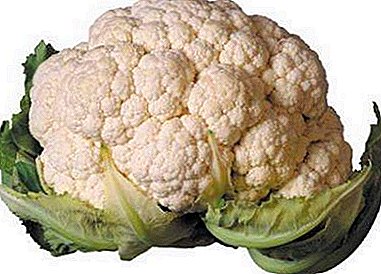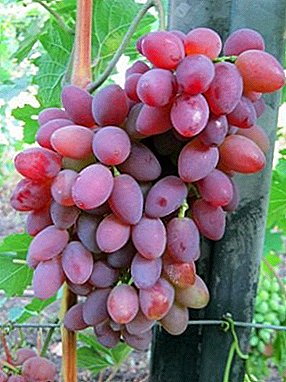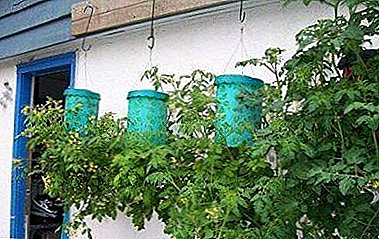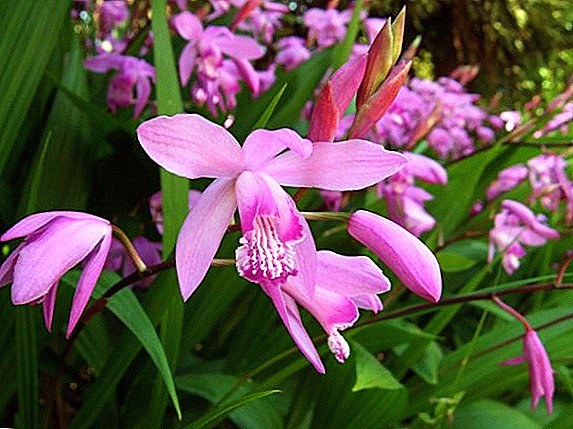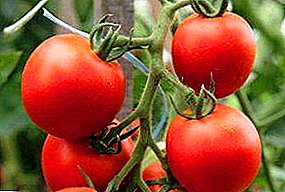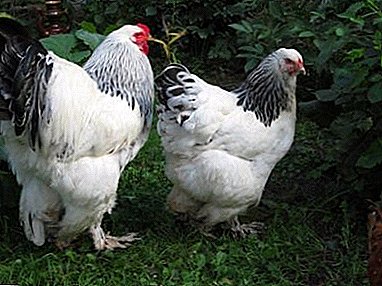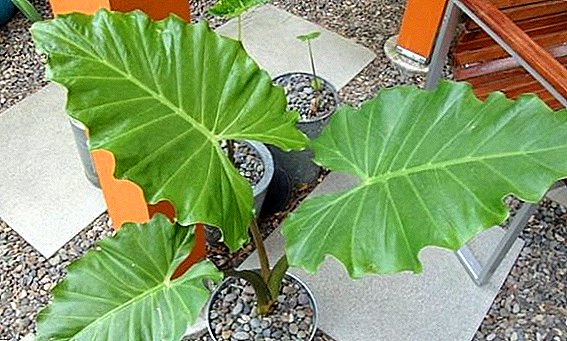 Large-root alocasia is rarely found in home-grown crops. This wild perennial grows in the south and southeast Asia, on the islands of Oceania, as well as in the rain forests of Australia. Recently, however, an exotic plant is gaining popularity among amateur growers around the world. This article provides simple recommendations, armed with which you can grow alokaziya in your own apartment.
Large-root alocasia is rarely found in home-grown crops. This wild perennial grows in the south and southeast Asia, on the islands of Oceania, as well as in the rain forests of Australia. Recently, however, an exotic plant is gaining popularity among amateur growers around the world. This article provides simple recommendations, armed with which you can grow alokaziya in your own apartment.
Botanical description of the plant
Alocasia large-root (mountain, lead-gray, thick-stemmed, large-root-less) is an evergreen, a species of the genus Alocasia, of the Aroid family. The Latin name sounds like Alocasia macrorrhizos. 
The plant is gigantic, very powerful, in favorable conditions of the wild nature grows up to 4 meters. The stem grows vertically to approximately 1.5 meters in height, then lies down. The length of the sheet reaches 1 m; the stalk of the leaf plate also has a similar length. The leaves are green, heart-shaped, shiny. Flowers inconspicuous, exude a pleasant aroma. Green parts of alokaziya contain an insignificant amount of juice, the color and consistency of milk. For large leaves with smooth edges, this species is popularly called "elephant ears".
In a closed environment, the flower will not be as stately as in natural habitats. Crop growth is limited by pot size and enclosed space. Dimensions of room alokazii range from 80 cm to 1.5 m in height and width.
Did you know? Due to the huge size of the foliage of the plate, the variety is listed in the Guinness Book of Records.
Plant properties
Various remedies on the basis of alokazii krupnokusneistojna marked with a healing effect. However, medicinal properties in nature often coexist with poisonous ones, the same applies to the represented plant.
Medicinal
For non-traditional medicine, the grass has been used by the Chinese for centuries. Today, it is used in their practice by doctors from India and Sri Lanka. The burning and caustic juice of this herb has a local irritant effect, distracting from unbearable pain in the joints.
Alocasia is endowed with other healing properties, it is in demand for the following ailments:
- osteochondrosis, arthritis, rheumatism, gout;
- thrombophlebitis and varicose veins;
- hemorrhoids;
- toothache;
- cholera
- open wounds and bruises, which are accompanied by bruising;
- pathologies of the thyroid gland;
- with neoplasms;
- with weak immunity and frequent infection of the body.
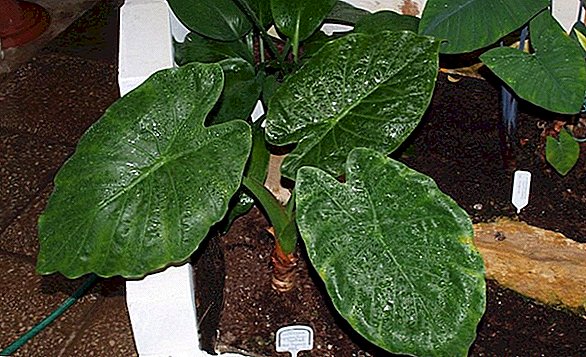
On the basis of the crushed above-ground parts, ointments, oils, slurries, tinctures on water and alcohol are made. Alcoholic natural medicine is obtained from a single leaf with a petiole. Grass insist in 0.5 liters of vodka in a dark place for about two weeks.
Harmful
European doctors have not studied this plant enough - there is no scientific evidence of its healing properties. In addition, there are no developed methods for internal and external consumption of alokaziya.
It is reliably known that the herb is toxic, it can bring not only relief, but also serious harm to the body. If used improperly, poisonous juice causes an allergic reaction, irritation or burns to the skin. And if you accidentally eat a piece of leaf, confusing alokaziya with ginseng, you can not avoid food poisoning.
Important! As alokaziya is poisonous, it is necessary to use medicines from it exclusively outwardly. And in order to avoid undesirable consequences of illiterate external use, consult with your doctor first.
Conditions for successful home cultivation
The species is recommended for keeping in spacious halls, rooms, salons, offices, offices, shop-windows or cafes.
Temperature
The culture feels comfortable at the indoor temperature within + 22 ... + 28 ° С in the summer. In the winter period, this figure should be reduced to + 18 ... + 20 ° С.
Air humidity
Once in the apartment, a moisture-loving tropical grass can suffer from an excessively dry microclimate, therefore, in the summer heat, Alokia root must be abundantly and often sprayed. Use for this warm, well-settled water.
In the winter months with a spraying, be careful, because high humidity combined with coolness can trigger rotting and mildew formation. In winter, it is better to limit wiping the leaves with a damp cloth. The procedure will remove the accumulated dust from the foliage, moisturize it, thus facilitating the access of air to the plant.

Location and capacity for growing
Alocasia large root does not tolerate through winds, and therefore place the pot away from the balcony doors and windows that open. The flower also does not like bright sunlight. Optimally, if you pick up a place in the penumbra.
The roots of a tropical stranger are poorly developed in breadth and actively down, so choose the appropriate capacity - deep and not too wide. The best material for the tank is plastic or ceramic.
Did you know? Alocasia has an interesting feature - it is able to give a weather forecast. On the eve of rain, large transparent drops of water appear on the surface of the leaves closer to the tips, like tears. Hence such popular names as “weather pod”, “live barometer”, “mourner”. But it is worth noting that the "predictions" of a flower can only be relied upon with the right watering.
Home care
When caring for "elephant ears", be guided by the conditions in which wild plants grow.
Watering
Alocasia loves moisture and negatively responds to its deficiency. But you can not overdo it with watering, especially in winter. The frequency of watering depends directly on the temperature. The hotter, the more frequent irrigation. In the summer months, water the flower 1 time in 2-3 days. In winter, limit to one irrigation in 8-10 days. Before the next moistening, wait until the surface of the earthen lump dries.
Use water that has settled for 6 hours. Its temperature should be 2-3 degrees above room temperature. Water from the pan by all means merge.

Top dressing
Begin to bring in nutrients from April to October - once every two weeks. Use universal mineral complexes for indoor plants. Top-dressings that contain a lot of nitrogen and potassium (for example, "Agricola 7") are very useful. It is advisable to alternate the minerals with organic matter diluted in a ratio of 1 to 30 and infused for 5 days.
In winter, it is better to refuse to make supplements. But if your flower continues to grow during this period, you can feed it a little (1 time per month). Dilute complex fertilizer 3 times more water than recommended on the package.
Important! Do not overdo it with fertilizers. Their excessive amount adversely affects the general condition of the plant.
Pruning
Tropical stranger practically does not need this manipulation. The only pruning to which you can resort is the so-called cleansing. The essence of the procedure is the removal of dead dried or rotten leaves. These sheets trim pruning shears to healthy tissue. Wounds do not forget to process wood ashes.
You can try to update alokaziya, cutting off all the leaves and leaving a bare trunk. Such cardinal pruning will wake dormant buds and make them grow. However, this is a rather risky operation that does not guarantee a successful conclusion. In addition, there is no special need for such a procedure, since smart alokaziya is able to update itself, throwing off old and extra leaves.

Transfer
If perennial looks healthy, transplanting for a young flower is required 1 time per year, and for an adult - every 2-3 years. The most favorable time for the procedure is the beginning of spring. With respect to adult alokazii, the method of transplantation is more often practiced with partial replacement of the upper layer of the substrate.
So, we suggest that you familiarize yourself with the detailed technique of transplanting an exotic plant:
- In the prepared container of a large size (made of plastic or ceramics), fill the drainage by about 1/3 of the total volume.
- Add some substrate (1 part of leafy ground, 1 part of humus, 1 part of peat, 0.5 part of sand). The soil should be slightly acidic (5.0-6.0 pH).
- Carefully remove the flower without breaking the coma of the earth. If the plant is transplanted for the first time after buying it in a store, it is better to wash the old soil from the roots with water. At the same time carefully inspect the rhizome - get rid of rotten areas. Treat your wounds with crushed activated charcoal, then dry for about an hour.
- Dip the rhizome into the pot, taking care not to damage it.
- Add fresh soil mixture to the sides, tapping the pot a little on a hard surface.
Important! Try not to penetrate the root collar, but not to tamp the ground.
Breeding types
At home, alokaziya can be propagated in different ways: by dividing the rhizome, by cutting, by seed.
Seeds
Seeds should be sown in a land mixture consisting of equal parts of sand and peat. Close the seed very close to the surface, then cover the container with glass or tighten it with a film.
From time to time remove the protection to moisten the soil. The temperature index in the room should be approximately + 24 ° C. After the appearance of sprouts, they need to dive, and after a while repeat the procedure. Then young plants require transplanting in small containers up to 7 cm in diameter. When the flower root system fills the entire container, Alocasia will need to be transferred to a larger pot.

Cuttings
The process of propagation by cuttings is:
- At an angle of 45 ° cut the apical or leaf cutting.
- Dry the material for 3-4 hours, and then process the root growth stimulator.
- Plant the prepared stalk into the substrate made from sand and peat.
- Cover the plant with a package, not forgetting to periodically air. Try to keep a humid, warm microclimate.
- After about a month, the roots will appear, and then a young leaf.
Cuttings root well in boiled water with a piece of charcoal added there.
Did you know? Among the supporters of the Feng Shui teaching, Alokazia is considered the patroness of the Moon, therefore, it is recommended to start uncontrolled and irritable people at home. The flower bestows its owner tolerance and gentleness.
Division
Propagation by rhizome division is a fairly simple method that can be combined with transplanting so as not to injure the flower once again:
- Get to work in late March or early April. Carefully remove the soil, taking care not to damage the delicate roots.
- Use a sharp tool to divide the rhizome so that there is a bud on each separated part with a rosette of leaves.
- When the cut dries, plant a flower in the ground and immediately moisten well. The temperature in the room should not be below + 24 ° C.
- Saplings often spray until the foliage again becomes elastic.

Possible problems with growing
Although home care for alokaziya krupnokornevoy is not so difficult, still some problems are not excluded.
Stagnant water sometimes leads to decay of the rhizome. The drying foliage indicates trouble. Finding a problem, pass the flower, cut rotten roots. In the new container, provide the plant with good drainage and light flooded soil. Immediately after moistening, drain water from the pan.
Pale, but not drying leaves indicate a lack of nutrients. Universal fertilizer slightly dilute and pour them "elephant ears."
Check out the popular types of alokazii.Malicious insects try to stay away from a toxic plant, so they rarely damage it. Alokaziya suffers from attacks of parasites, only being weakened by improper care. A spider mite can start up on the leaf plates if it is not sprayed with a flower and does not moisten the air. In the fight against this parasite, wash the foliage with water, treating it with a weak tobacco extract or insecticide against the tick (Vermitek, Fitoverm, Aktofit).
If you like exotic unusual plants, then you should definitely plant a large root alokaziya at home. Having grown this flower, you will get not just a luxurious decoration for the interior of the room, but also become the owner of a whole green pharmacy.



